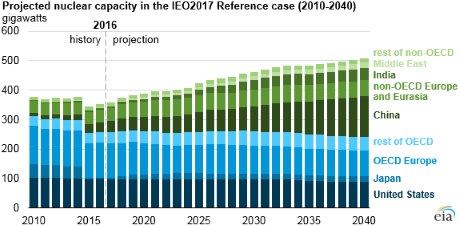Non-OECD countries to lead nuclear growth: EIA
10 November 2017
Global nuclear capacity will grow at an average of 1.6% per year from 2016 to 2040, according to the US Energy Information Administration (EIA). The growth will be led predominantly by countries outside the Organisation for Economic Cooperation and Development (OECD).
 |
| EIA's projection for nuclear (Image: EIA) |
Citing its International Energy Outlook 2017, published in September, the EIA yesterday said it expects China to continue leading world nuclear growth, followed by India. This growth is expected to offset declines in nuclear capacity in the USA, Japan, and Europe.
With electricity demand playing a central role in decisions to build - or retire - nuclear capacity, the EIA said it expects electricity demand growth in China, India, and the Middle East to exceed growth in the USA, Europe, and Japan. Its higher projected electricity demand growth for non-OECD member countries is the result of comparatively higher growth in gross domestic product and population relative to OECD member countries, it said.
The organisation expects China, currently accounting for more than a third of all nuclear projects under construction worldwide, to complete plans to install 58 GWe of new nuclear capacity by 2024.
"By 2032, China is expected to surpass the United States as the country with the most nuclear electricity generating capacity," the EIA said.
By 2040, the its Reference Case scenario sees world installed nuclear generating capacity totalling 507.6 GWe, up from 352.0 GWe in 2016.
The EIA is a US federal agency responsible for collecting, analysing and disseminating independent and impartial energy information.
Researched and written
by World Nuclear News